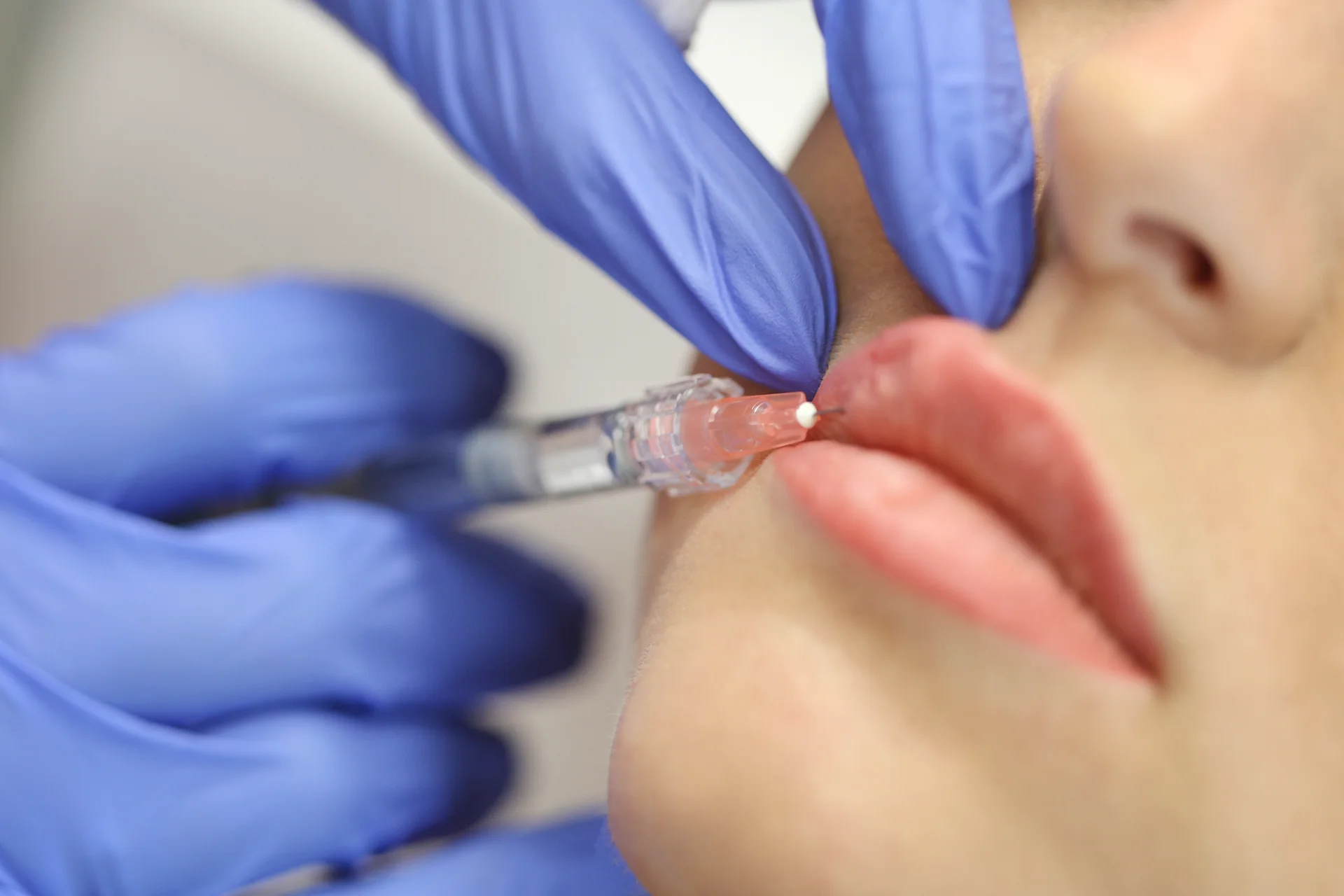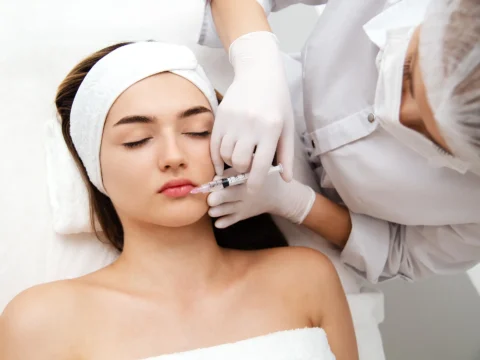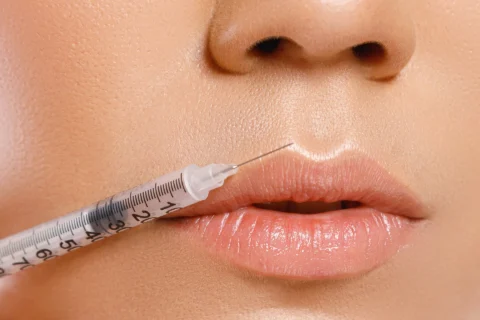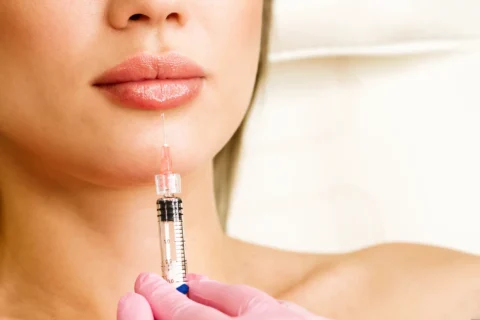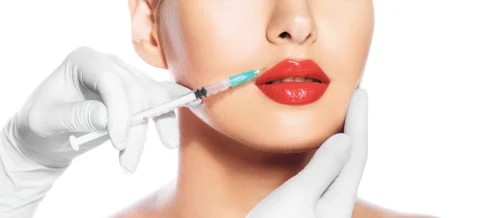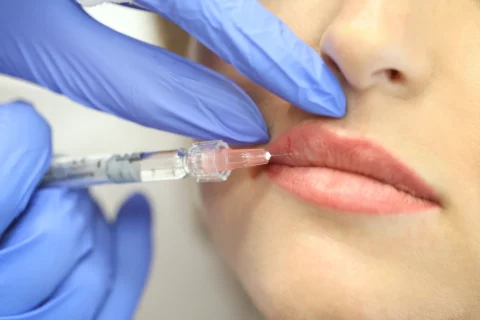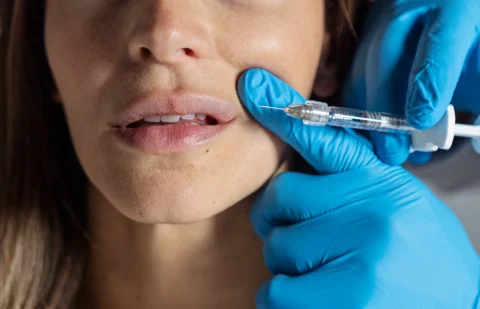The Healing Process: Managing and Reducing Bruising
Bruising is a frequent and natural response to lip filler treatments. It’s caused by the disruption of blood vessels in the sensitive lip area during the injection process.
Recognizing the factors that contribute to bruising, its usual duration, effective reduction methods, and signs that warrant medical consultation is essential for anyone considering or undergoing lip filler procedures.
What Causes Bruising After Lip Filler Procedures?
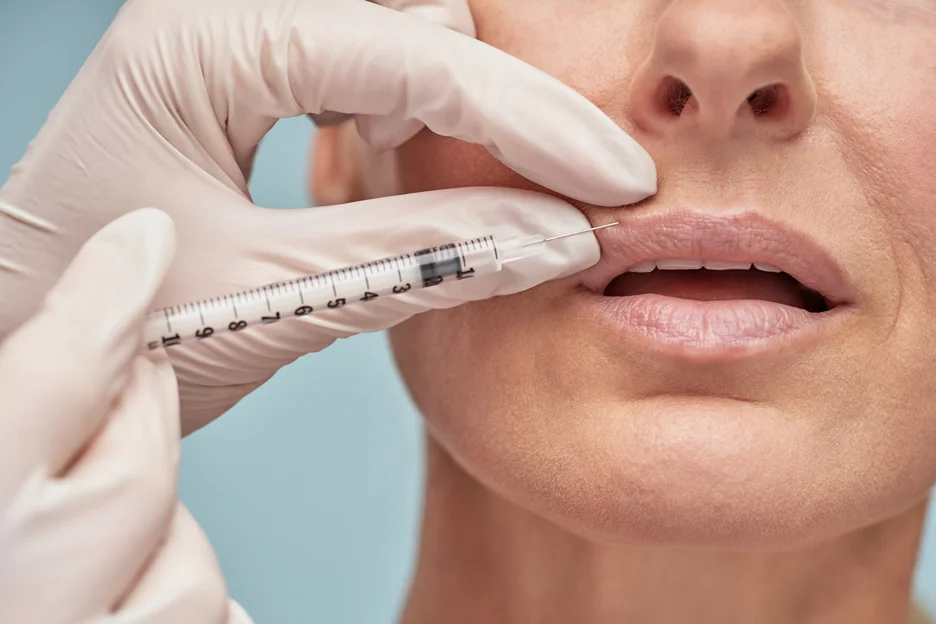
Bruising is a common side effect of lip filler procedures. It occurs when the injection needle damages a blood vessel in the lips. The lips have many nerve endings and blood capillaries, which makes avoiding bruising challenging.
When a blood vessel is damaged, white blood cells go to the area, resulting in a bruise. The more injections are made, the higher the chance of bruising.
Skilled practitioners, well-versed in facial anatomy, employ specific techniques to minimize the risk of bruising, such as:
- Strategically injecting the filler at minimal locations to reduce tissue disruption.
- Utilizing microcannulas with blunt tips, which are less likely to puncture blood vessels compared to traditional needles.
- Administering the filler in small quantities to lessen the impact on the surrounding tissues.
- Ensuring the filler is injected no deeper than 2.5 mm beneath the skin’s surface to steer clear of major blood vessels.
Even with careful precautions and the expertise of seasoned injectors, bruising can still occur after lip filler procedures. This is largely due to the inherent sensitivity and the dense network of blood vessels in the lip area.
Additionally, other factors can heighten the risk of bruising. These include taking blood-thinning medications, having a history of cold sores, and having high blood pressure. Each of these can contribute to increased bleeding and bruising in the lip area.
Being aware of these factors is important for understanding and managing the risk of bruising with lip fillers.
How Long Does Bruising Typically Last After Lip Fillers?
Bruising from lip fillers typically reaches its peak 1-3 days post-treatment.
Dr. Soni notes that on average, bruising is noticeable for about 5-7 days. However, individual healing times can vary. Some patients may see their bruising fade within 3-4 days, while for others, it might last up to 10-14 days.
It’s important to be patient during this time, as the body needs to reabsorb the blood from the injection sites and restore normal circulation. Generally, signs of improvement become visible within a week, with bruises gradually lightening in color.
How Can I Minimize Bruising After Lip Filler Treatments?
Dr. Soni suggests several best practices to reduce bruising risks before and after lip filler appointments:
Before Your Appointment
- Avoid alcohol for 24-48 hours beforehand. Alcohol thins your blood, increasing the likelihood of bruising.
- Steer clear of aspirin or ibuprofen during the same period. Like alcohol, these can thin your blood.
- Keep yourself well-hydrated. Adequate water intake aids in faster healing.
During Your Appointment
- Request the use of a blunt-tip needle from your injector. This type of needle can lessen the bruising risk.
- Suggest the application of ice packs before and after injections. Ice helps constrict blood vessels, reducing swelling and bruising.
After Your Appointment
- Apply ice packs to your lips for 10-15 minutes several times a day.
- Sleep with your head elevated to minimize swelling.
- Refrain from excessive lip contact, such as kissing or touching.
- Continue avoiding alcohol and smoking.
- Consider taking Arnica supplements. Arnica, a natural herb, is known for its bruise-reducing and anti-inflammatory properties.
While these tips can significantly reduce bruising, it’s normal to experience some bruising after injections. If you have concerns, always consult your doctor.
Additional Tips for Recovery
- Eat healthily. A diet rich in fruits, vegetables, and whole grains supports quicker healing.
- Ensure adequate sleep. Rest is crucial for recovery.
- Avoid heat exposure. Heat can widen blood vessels and worsen bruising.
- Use gentle skincare products. Harsh products can irritate your skin and slow down healing.
Following Dr. Soni’s advice can help minimize extent and duration of bruising. However, some mild bruising is expected with most patients.
When Should You Be Concerned About Bruising?
While bruising in the lip area is a typical response to filler injections, Dr. Soni advises paying attention to certain signs that may require medical consultation:
- Spread of Bruising: If the bruising extends beyond the lips, reaching down to the chin or other facial areas, it’s advisable to seek medical advice.
- Pain Levels: Severe or increasing pain at the injection sites should not be ignored. This could be a sign of an underlying issue.
- Swelling and Lumps: Noticeable hard, swollen lumps under the skin around the injection area can indicate complications and should be evaluated by a professional.
- Bleeding Issues: If bleeding at the puncture points persists or is difficult to control, it’s important to get it checked.
- Persistent Bruises: Bruises that show no signs of fading or changing in appearance after 10-14 days could be a cause for concern.
Additionally, bruising can also be a sign of infection. If you experience any of the following symptoms, along with bruising, seek medical attention immediately:
- Fever: An elevated body temperature can indicate an infection.
- Chills: This can be another sign of infection, especially if accompanied by fever.
- Drainage from the Injection Site: Any unusual discharge from the injection points is a red flag.
- Redness or Warmth at the Injection Site: These are classic signs of infection and should not be overlooked.
These symptoms can sometimes signal more serious complications, such as vascular occlusion, infection, or an allergic reaction, which require immediate attention to prevent permanent damage to the lip tissues.
Regular follow-up appointments with your filler provider are crucial for monitoring recovery and addressing any concerns promptly.
Remember, while some bruising and discomfort are expected, any unusual or prolonged symptoms should be evaluated by a healthcare professional to ensure safe and effective healing.
Conclusion: Embracing the Process for Desired Results
Bruising from lip fillers is a normal, short-term part of the process. It’s important to have realistic expectations and follow good aftercare.
This includes avoiding certain medications, staying hydrated, and following your doctor’s advice. A healthy lifestyle, with a good diet and enough rest, also helps in healing.
Dr. Hardik Soni advises patience and proper aftercare for the best results. Trust in your practitioner’s expertise.
With the right care, you can achieve beautiful, satisfying results from your lip enhancement treatments. Remember, a little time spent on healing can lead to rewarding outcomes.
FAQs on Bruising After Lip Filler Treatments: Understanding, Managing, and Recovery Tips
What does normal bruising look like after lip filler?
Normal bruising after lip filler can appear as small, reddish-purple marks around the injection sites. These bruises may slightly swell and change color over time, turning yellowish as they heal.
How much bruising is normal after lip fillers?
The extent of bruising varies per individual. Generally, mild to moderate bruising is normal, covering small areas around the injection sites. Severe or widespread bruising is less common and may require medical attention.
Why do you bruise after lip filler?
Bruising occurs because the lip filler needle can disrupt the blood vessels in the sensitive lip area. This causes blood to leak into the surrounding tissues, resulting in a bruise.
How can I reduce bruising after lip filler treatments?
To minimize bruising, avoid blood-thinning medications and supplements before your appointment, stay hydrated, and choose an experienced injector. After the procedure, apply cold compresses and keep your head elevated.
Is it normal for bruising to change color after lip fillers?
Yes, it’s normal for bruises to change color as they heal, typically transitioning from red or purple to yellow or green before fading completely.
Experience Expert Care for Your Lip Enhancement at Ethos Aesthetics + Wellness
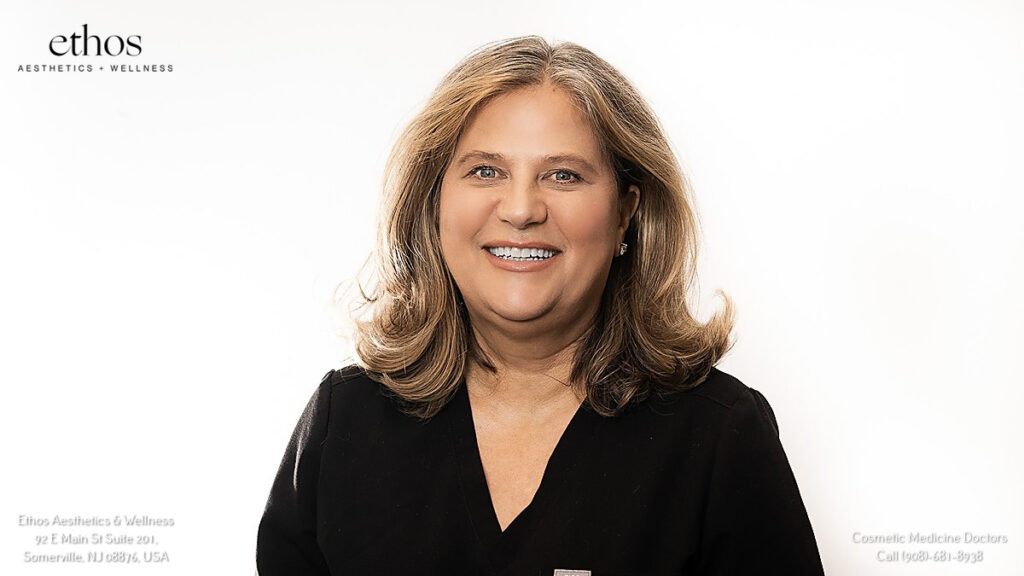
At Ethos Aesthetics + Wellness, led by Dr. Hardik Soni, we prioritize your safety and satisfaction. Our skilled team is dedicated to providing lip filler treatments with precision and expertise, aiming for a smooth, bruise-free experience. Book your consultation today and embrace the confidence that comes with expert care.

